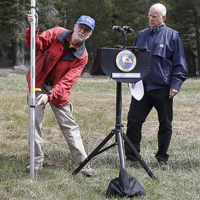Third of State’s Water Supply Threatened by Worst Snowpack in at Least 500 Years
 Gov. Jerry Brown watches “snowpack” measured in April. (photo: Rich Pedroncelli, Associated Press)
Gov. Jerry Brown watches “snowpack” measured in April. (photo: Rich Pedroncelli, Associated Press)
Milestones in California's four-year-old drought have been plentiful, but seem to grow less news worthy as they proliferate. A study released on Monday in Nature Climate Change appears to cross the threshold of significance.
Snowpack in the Sierra Nevada Mountains, a critical source of water for the entire state, hasn't been this skimpy in at least 500 years. Data from growth rings of trees in the area show the situation is much worse than back in April when snowpack was measured at 6% of normal and Governor Brown delivered the bad news from a barren Sierra Nevada meadow that hadn't been snowless in 75 years.
“We expected it to be bad, but we certainly didn’t expect it to be the worst in the past 500 years,” study co-author Valerie Trouet told the New York Times. The snowpack is pretty much zero percent of normal.
Well, maybe not absolutely “the worst.” The report admits that “our error estimation indicates that there is a possibility that a few (primarily sixteenth century) years exceeded the 2015 low,” but generally speaking, snow water equivalent (SWE) this bad only rolls around every 3,100 years.
The study said the current level of snowpack would be that unusual under normal historical conditions, but that was before human beings baked, broiled and microwaved the planet. The combination of low precipitation and high temperatures has ratcheted up dire assessments of future snowpack. California currently counts on it for 30% of its drinkable water.
Researchers combined two sets of data drawn from 1,500 blue oak trees at 33 sites in the Central Valley. After correlating precipitation levels with recorded snowpack levels from 1930 to 1980, the researchers applied the correspondence to temperatures from 1500 AD to 1980.
The researchers said the state's current dreadful rainfall numbers are within historical bounds of variability and wouldn't, by themselves, be cause for apocryphal hand wringing. But global warming increases the interval of disastrous drought by threatening to evaporate whatever precipitation comes our way or changes its form. El Niño, the ginormous atmospheric condition that scientists say could dump enormous amounts of precipitation on the state for months beginning this winter, would have far less impact in the Sierra Nevada if it rains instead of snows.
Californians and their policymakers are still mostly dealing with the drought as if it were a cyclical occurrence demanding short-term sacrifice and, perhaps, that it is a harbinger of future difficulties requiring more long-term adjustments down the road. But Peter Gleick, president and co-founder of Pacific Institute, told Climate Central, welcome to the “new unpleasant reality. . . . We need to rethink the way we manage the [water] system now.”
–Ken Broder
To Learn More:
California's Sierra Nevada Snowpack Is the Lowest in 500 Years (by Doyle Rice, USA Today)
Study Finds Snowpack in California’s Sierra Nevada to Be Lowest in 500 Years (by Nicholas St. Fleur, New York Times)
Sierra Nevada Snowpack Hit a 500-Year Low in 2015 (by Monte Morin, Los Angeles Times)
In California, a Paltry Snowpack Not Seen in Centuries (by Andrea Thompson, Climate Central)
Tree Rings Don’t Lie: It’s the Worst California Drought in at Least 1,200 Years (by Ken Broder, AllGov California)
Multi-Century Evaluation of Sierra Nevada Snowpack (by Soumaya Belmecheri, Flurin Babst, Eugene R. Wahl, David W. Stahle and Valerie Trouet, Nature Climate Change)
- Top Stories
- Controversies
- Where is the Money Going?
- California and the Nation
- Appointments and Resignations
- Unusual News
- Latest News
- California Forbids U.S. Immigration Agents from Pretending to be Police
- California Lawmakers Urged to Strip “Self-Dealing” Tax Board of Its Duties
- Big Oil’s Grip on California
- Santa Cruz Police See Homeland Security Betrayal in Use of Gang Roundup as Cover for Immigration Raid
- Oil Companies Face Deadline to Stop Polluting California Groundwater





